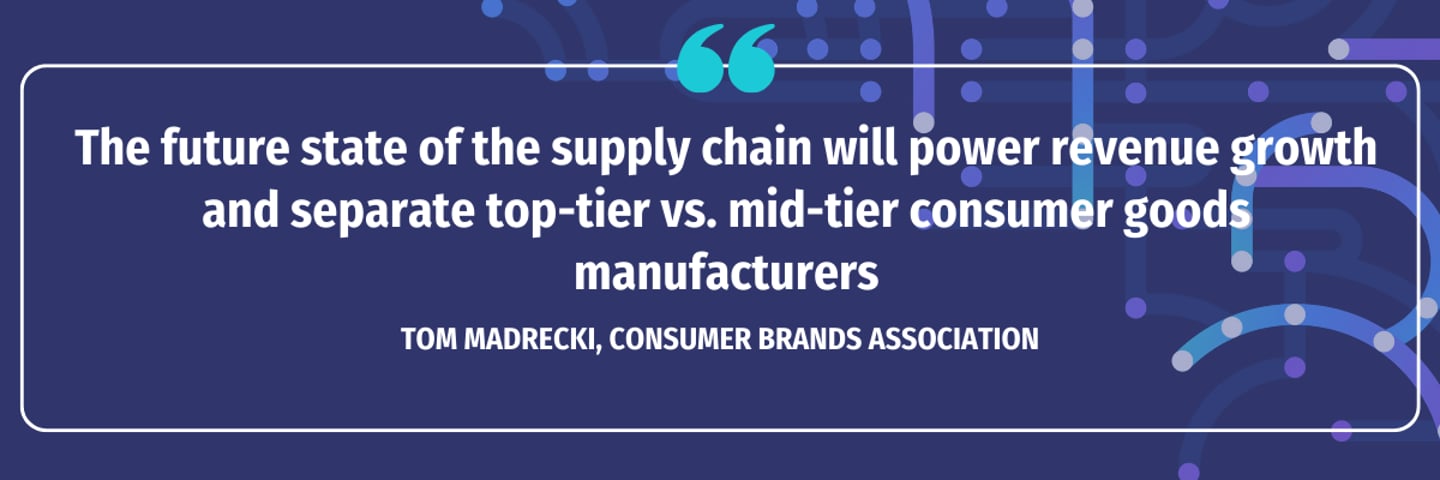What is the Future of Supply Chains 2025?
Top CPG companies are looking into their crystal balls holding a number of hopes for the future of supply chains and the impact of supply chain technology trends. However, there are many scenarios — best case, and worse — they’ll also be prepping for as they forge ahead.
One thing is for sure though: Past mistakes and forces beyond their control have made it imperative to build a more resilient, agile, and robust supply chain of the future.
What is the biggest threat to the functioning of supply chains in the future?
Supply chains have a tough time weathering volatility and are vulnerable to domino effects. Many of us will remember the Suez Canal Blockage of 2021, when a single vessel blocked a key trading artery, leading to a staggering $60 billion worth of trade getting thrown into disarray and delay. In this sense, the biggest threat to the functioning of the future supply chain is anything that contributes to disruption on a global scale.
Looking ahead, John Harmon, senior analyst at Coresight Research, says the top issues of the future will be political in nature, along with manmade shortages: “Geopolitical issues such as the U.S.'s blocking of the shipment of advanced semiconductor manufacturing equipment to China will play a role. There is also the challenge that chipmakers are financially motivated to build factories with state-of-the-art equipment, rather than prior-generation equipment, which could create shortages of these simpler chips as the electrification of consumer goods grows.”
Disconnected data also has the potential to undermine companies’ ability to produce high-quality goods, a particular pain point for consumer goods companies.
“This disconnectivity can create supply chain delays, unplanned supplier changes, or missed deadlines, all of which impact not only the quality of the customer experience but the quality of the products,” shares Ara Surenian, VP product management at Plex by Rockwell Automation. In fact, almost half (45%) of companies list quality as the motivator for digital transformation and prioritize connected data through adopting automation-enabling smart manufacturing technology, according to Plex.
Agility — underpinned by a robust data infrastructure — will be crucial. Mahesh Rajasekharan, Cleo CEO, puts it frankly: “If your supply chain continues to lack fluidity of information, real-time actionable insights won’t be available to you. And without an ecosystem-first integration-driven supply chain supporting your business, you’ll miss out on opportunities to beat your competition.”
What will supply chain be like in the future?
Although digital supply chain management will continue to fashion a new-look ecosystem with a more autonomous supply chain, the people driving these systems will be increasingly important.
“Talent and supply chain success go hand in hand,” notes Douglas Kent, EVP of strategy and alliances at the Association for Supply Chain Management (ASCM). “It’s critical we foster new generations of supply chain talent and train and upskill logistics and manufacturing professionals to use digital tools and adapt to adverse events and fluctuating market trends."
More specifically, experts point to diversification as a North Star for supply chain leaders. As geopolitical risks cast a long shadow, many CPG companies will aim to regionalize their networks to be less vulnerable.
“The best way to mitigate that risk is to diversify supply chains away from a single source to ensure any unforeseen impact to one manufacturing hub doesn’t shut down the company’s operations,” says Mike Graziano, consumer products senior analyst with RSM US.
What are supply chain predictions for 2023?
Shifting the timeline back to the present, experts are making a number of supply chain predictions for 2023. Looking at the bigger picture, the focus remains on recasting the supply chain as a centralized backbone of value creation and breaking down silos.
Cleo’s Rajasekharan says this convergence is already happening but needs to continue. This involves identifying broken functional silos within a consumer goods company and developing ways to reconstruct them to yield end-to-end business processes that span, synchronize, and optimize across different traditional functional domains under an “ecosystem-first” perspective, he shares.
Lofty-seeming goals surrounding sustainability and digital transformation are not out of the question, says Tom Madrecki, VP of supply chain at Consumer Brands Association, “but this isn’t just about envisioning supply chain as an efficiency engine — the future state of the supply chain will power revenue growth and separate top-tier vs. mid-tier consumer goods manufacturers.”




